I have been, or can be if you click on a link and make a purchase, compensated via a cash payment, gift, or something else of value for writing this post. As an Amazon Associate, I earn from qualifying purchases. Please read my full Affiliate Disclosure for more information.
Imagine walking into a living room that feels spacious, inviting, and perfectly tailored to your lifestyle—that’s the magic of well-thought-out long living room layouts. These designs have surged in popularity because they maximize open space, promote social interaction, and offer endless opportunities for creativity in decorating.
In this article, you’ll explore a variety of inspiring layout ideas that can transform your open space into a harmonious and functional area. Whether you prefer modern minimalism, cozy nooks, or stylish zoning, there’s an idea here to spark your imagination and help you craft the perfect living area for your home.
1. Define Zones with Area Rugs to Create Distinct Living Areas

Ever feel like your enormous living room just swallows everything whole? Without proper zones, it can feel like a never-ending space that’s hard to cozy up in. You want each corner to serve a purpose but still look seamless and inviting. Creating distinct areas in a long room helps you feel organized and less overwhelmed.
Imagine walking into your living space and instantly recognizing a cozy reading nook with a plush, textured rug under a comfy chair. Nearby, a sleek, patterned rug anchors the TV zone, while a soft, neutral-toned runner connects the conversation area. The different rugs add warmth and define spaces without blocking the flow. The mix of colors, textures, and patterns makes your room feel layered and intentional.
You can switch up rug styles based on seasons or moods—think a bold geometric for summer and a shaggy, cozy one for winter. For smaller spaces, opt for smaller rugs that still define each zone, while large, oversized ones work for open-concept rooms. If your style leans toward minimalism, choose monochrome or neutral tones. For eclectic vibes, mix patterns and textures freely.
Start by identifying the main functions of your space—seating, entertainment, reading, or working. Measure and select rugs that fit each area, ensuring they are large enough to anchor furniture but not so big that they overpower. Use contrasting or complementary colors to create visual separation. Place furniture partially on the rugs for a natural look. Layering rugs or adding small accent rugs can enhance the zoning effect. Keep walkways clear to maintain flow.
Add personal touches like fringed edges or layered textures to make zones cozy. Incorporate subtle color coordination with pillows or throws that echo the rug hues. Use different pile heights—shaggy for lounging, flat-woven for dining areas—for added interest. Consider using lighting accents like table lamps or sconces near each zone to reinforce the separation.
Defining zones with rugs transforms your long living room into a series of intimate, purposeful spaces. It boosts functionality and style simultaneously. With a little effort, your open space will feel more inviting and less daunting. Ready to create a layout that’s both functional and fabulous?
2. Arrange Furniture in a Linear Layout for Seamless Flow

Long, narrow living rooms often feel like they stretch endlessly, making it hard to create a cozy seating arrangement. Without a thoughtful layout, it can seem more like a hallway than a relaxing lounge. The goal is to maximize the space while maintaining an open, flowing feel that invites conversation.
Picture a long room where a sleek sofa runs parallel to the length, with matching armchairs on either side, all aligned in a straight line. A narrow console table behind the sofa adds a functional surface for decor or daily essentials. Natural light streams through windows, highlighting the open pathway between seating clusters. The furniture’s linear arrangement emphasizes the room’s length, making it feel more spacious.
Choose slim-profile furniture to prevent bulkiness—think low-profile sofas and streamlined chairs. For a more modern vibe, opt for sectional sofas that run along the room’s length. If you want a softer look, add plush textiles and rounded edges. For multi-purpose spaces, incorporate fold-out or extendable pieces that adapt to your needs.
Start by measuring your room’s length and width. Position the main sofa along one side, leaving enough space for walkways. Place chairs facing the sofa to encourage conversation, keeping enough distance for comfort. Use rugs to anchor the seating area and define the space. Keep traffic routes clear to preserve the flow. For added cohesion, align furniture legs or backs along the room’s central axis.
Personalize with throws, cushions, or unique upholstery fabrics that match your style. Add a long, sleek mirror along the wall to reflect light and visually extend the space. Incorporate a series of small side tables or storage units for convenience. Use artwork or decorative accents along the length of the room to create visual interest.
A linear furniture setup creates a harmonious flow and highlights the room’s natural proportions. It’s a simple yet effective way to make your long living space feel inviting and well-organized. With this layout, you’ll enjoy easy conversation and effortless movement. Ready to straighten out your space for maximum impact?
3. Use Multi-Functional Furniture for Versatile Living Spaces

Does your long living room feel cluttered and chaotic? Without versatile furniture, small spaces can quickly become overwhelming. You need pieces that serve multiple purposes, so your space stays open and flexible. Multi-functional furniture is the secret to keeping things tidy without sacrificing style.
Imagine a cozy ottoman that opens up to store blankets and magazines, doubling as extra seating. A sleek coffee table extends into a dining surface when needed, perfect for entertaining. A sofa bed provides overnight guest accommodations while blending seamlessly into your decor. These clever pieces look stylish and hide clutter, making your room feel spacious and organized.
Select furniture with integrated storage, such as beds with drawers or shelves built into side tables. For a minimalist look, choose sleek, simple designs with hidden compartments. In more playful spaces, opt for colorful or patterned multifunctional pieces. For seasonal updates, swap out soft furnishings or covers that are easy to change.
Start by assessing your needs—do you entertain often or need guest accommodations? Choose pieces that can switch functions easily, like sofa beds or extendable tables. Prioritize quality and durability, especially for high-use items. Measure your space to ensure pieces fit comfortably without blocking pathways. Use furniture with hidden storage to hide away clutter and maintain a clean look. Assembly might require some effort, so plan accordingly.
Add decorative cushions or throws to change the look seasonally. Incorporate modular pieces that can be reconfigured for different activities. Use color-coordinated storage bins or baskets to keep belongings tidy. Personalize with accessories that reflect your personality, like funky handles or custom upholstery.
Multi-functional furniture unlocks the full potential of your long living room. It combines practicality with style, making your space adaptable and clutter-free. Once you embrace this approach, you’ll wonder how you ever managed without it. Get ready to enjoy a flexible, stylish, and organized living area!
4. Incorporate Open Shelving to Divide and Decorate

Long living rooms can feel like a blank canvas, but without proper division, they might also seem endless and impersonal. You want to add character and functionality without closing off space. Open shelving offers a clever way to partition while keeping the room airy and stylish.
Visualize sleek, linear shelves running along the length of the room, holding books, decorative boxes, and personal mementos. The open design allows light to flow freely, preventing the space from feeling cramped. The shelves add architectural interest and a place to showcase your personality, all while subtly defining different zones.
Choose floating wood or metal shelves for a modern look, or vintage-inspired open racks for a cozy vibe. Vary the height and depth of shelves for visual interest. You can keep shelves minimalist or load them up with decorative objects to add personality. Use brackets or hidden supports to keep the design clean.
Start by determining where to create visual separation—near the seating area or along a wall. Mount shelves at varying heights to add dimension. Use lightweight materials for easy installation. Arrange items thoughtfully—balance colors, sizes, and textures for a cohesive look. Ensure shelves are sturdy enough for your intended use. Regularly update or rotate decor to keep the space fresh.
Add decorative storage boxes or baskets to hide clutter. Incorporate sculptural objects or textured containers to elevate the look. Use lighting like LED strips behind shelves for subtle illumination. Personalize with items that tell your story, such as travel souvenirs or family heirlooms.
Open shelving combines function and style effortlessly, making your long room feel curated and welcoming. It’s a flexible solution that adapts to your changing tastes and needs. With a little creativity, your space will feel more dynamic and inviting. Time to open up and showcase your style!
5. Place a Long, Low Profile Sofa for a Cohesive Look

Long living rooms can sometimes feel disjointed or awkward if the furniture is too bulky or mismatched. You want a centerpiece that unifies the space without overwhelming it. A long, low-profile sofa can do just that, creating a harmonious and inviting environment.
Imagine stretching out on a sleek, elongated sofa with soft, neutral upholstery that runs almost the entire length of the room. The low back and streamlined design keep the space feeling open, while the sofa anchors the room beautifully. Pair it with a series of small accent tables or poufs for added flexibility. The entire setup emphasizes the room’s length and creates a natural gathering spot.
Choose a neutral or monochrome fabric for a clean look, or go bold with textured or patterned upholstery. Incorporate modular pieces that can be rearranged or extended as needed. For a softer aesthetic, add layered textiles like throws and cushions. For a more contemporary vibe, stick to minimalist lines and subtle colors.
Measure your space carefully to find a sofa that fits well without blocking pathways. Opt for low-profile frames that don’t dominate the room. Position the sofa parallel to windows or along the longest wall to maximize openness. Complement with a series of small tables or a runner rug underneath. Keep the layout flexible for easy reconfiguration.
Add cushions with different textures and colors to make it cozy. Use a mix of soft throws or blankets for a layered look. Personalize with subtle decorative accents like sculptural side tables or sleek storage units nearby. Keep the decor minimal to let the sofa remain the focal point.
A long, low sofa visually lengthens your space and simplifies your layout. It creates a relaxed, cohesive atmosphere that encourages conversation. With the right choice, your long living room transforms into a stylish, functional retreat. You’ve got this—time to make it happen!
6. Create a Focal Point with a Long Gallery Wall

Long living rooms can lack a visual anchor, making the space feel scattered or unfinished. You want something that draws the eye and adds personality without cluttering the room. A long gallery wall is the perfect way to create a striking focal point and tie the space together.
Picture a continuous line of framed photos, artwork, or printed textiles stretching along a wall. The varied sizes and frames add visual rhythm, guiding the eye across the room. This display acts as a visual anchor, transforming an empty wall into a curated art piece. The arrangement brings warmth, personality, and a sense of cohesion.
Opt for a uniform frame style for a minimalist look or mix different frames for an eclectic vibe. Use a color palette—black and white or matching tones—to create harmony. You can also incorporate textured or fabric-backed pieces for added depth. Keep the layout balanced but freeform for a relaxed atmosphere.
Begin by choosing a wall that naturally attracts attention. Lay out your frames on the floor first to experiment with arrangements. Use painter’s tape to mark the positions on the wall. Hang each piece carefully, maintaining consistent spacing. Mix different art styles or photographs to keep it engaging. Regularly refresh with new pieces or rearrangements to keep the display lively.
Add personal touches like favorite quotes or memorabilia integrated into the gallery. Use lighting such as picture lights or sconces to highlight the display. Incorporate a few sculptural or textured elements for visual interest. Keep it balanced to avoid overwhelming the rest of the room.
A gallery wall turns an empty space into a statement, adding depth and interest. It reflects your personality and creates a memorable visual experience for visitors. With a little effort, your long wall becomes a captivating centerpiece. Time to curate your story!
7. Use Vertical Storage Solutions to Maximize Floor Space

In a long living room, clutter can quickly pile up, making the space feel chaotic. Floor space is precious, but horizontal storage often eats into it. Vertical storage solutions help you reclaim floor area while offering ample room for everything you need.
Imagine tall, slim bookcases lining the walls, filled with neatly stacked books, baskets, or decorative boxes. Wall-mounted cabinets or shelving units rise up toward the ceiling, providing storage without sacrificing style. The vertical lines draw the eye upward, emphasizing the room’s height and length. This creates a sleek, organized look that feels open and airy.
Choose open or closed units depending on your preference—open shelves for display, cabinets for hiding clutter. Use adjustable or modular systems to adapt as your storage needs change. For a warm feel, opt for wooden finishes; for a contemporary vibe, go for metal or lacquered surfaces. Integrate decorative baskets or bins to keep things tidy.
Start by assessing what you need to store—books, media, accessories. Mount wall shelves at varying heights for visual interest and accessibility. Tall bookcases work well in unused corners or along narrow walls. Secure heavy units to the wall for safety. Keep pathways clear and avoid overstuffing to maintain an uncluttered look. Consider custom built-ins for a seamless appearance.
Add decorative elements like framed photos or sculptural objects on open shelves. Use color-coordinated storage bins to keep everything organized. Incorporate lighting inside cabinets or along shelves for a warm glow. Personalize with mementos or favorite collectibles to make the space uniquely yours.
Vertical storage unlocks the potential of your long living room by freeing up precious floor space. It creates a clean, modern aesthetic that’s both functional and attractive. Once you master this approach, clutter becomes a thing of the past. Your room will feel bigger, brighter, and more inviting.
8. Incorporate Light, Airy Window Treatments to Enhance Natural Light

Long living rooms often struggle with uneven lighting, making parts of the space feel dark or closed in. Heavy curtains or blinds can block natural light, dampening the room’s energy. You want window treatments that brighten your space and keep it feeling open and fresh.
Visualize sheer, flowing curtains that catch the breeze and diffuse sunlight softly across the room. Light-colored blinds or shades can be easily drawn back to flood the space with daylight. The fabric or material adds texture without bulk, allowing the room to breathe. The light-filtering effect creates a cheerful, welcoming atmosphere.
Choose from a range of fabrics—linen, voile, or lightweight cotton—for a breezy vibe. For a more modern look, opt for minimal roller shades or sleek cellular blinds. Layer curtains with a thin blackout lining for versatility. Match the color palette to your decor—neutral tones or subtle patterns work well in most spaces.
Measure your windows carefully to select the right size and style. Install curtain rods or tracks high above the window frame to make the windows appear taller. Use lightweight fabrics for easy maintenance and cleaning. Keep the hardware simple and unobtrusive. Consider motorized options for added convenience. Regularly wash or refresh the treatments to maintain a bright, airy feel.
Use decorative tiebacks or curtain hooks to add a personal touch. Incorporate subtle trims or edging for extra detail. Layer different fabrics or textures for depth. Match your window treatments with cushions or throws to create a cohesive look. Play with patterns or solids based on your room’s overall style.
Bright, light-filled rooms boost mood and make your long living space feel more expansive. They highlight architectural features and create a sense of openness. With the right window treatments, your room will radiate freshness and vibrancy. It’s time to embrace natural light as your design ally.
9. Position a Long Console Table Behind a Sofa for Added Functionality
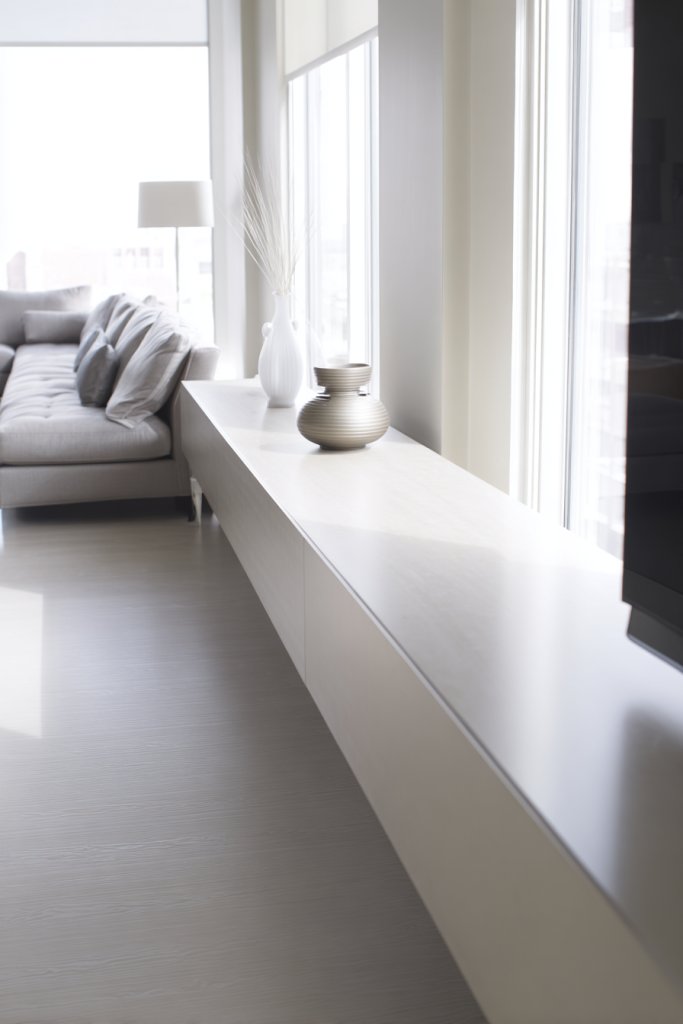
Long living rooms often lack surface space for daily essentials or decorative accents. You don’t want clutter piling up on your main furniture pieces or taking up precious real estate. A long console table behind your sofa adds functionality without disrupting the flow.
Picture a sleek, narrow console stretching along the back of a large sofa, holding a lamp, a few decorative objects, and a tray for keys. The table’s slim profile keeps the space open, while its surface adds a layer of visual interest. It acts as a buffer zone, making the room feel more organized and intentional. Natural light from nearby windows highlights its streamlined silhouette.
Choose materials like wood, metal, or lacquered finishes to match your decor style. Decorate with minimal accessories—think decorative trays, small sculptures, or seasonal accents. For a more eclectic vibe, mix vintage and modern pieces. Adjust height to align with sofa arms for a seamless look.
Measure the sofa’s width to select an appropriately long table. Position the table directly behind the sofa, ensuring enough clearance for comfortable movement. Use non-slip pads or furniture grippers to keep the table stable. Decorate with items that are easy to remove or change for seasonal updates. Keep clutter minimal for a clean aesthetic.
Personalize with decorative trays or bowls for keys and mail. Add a few framed photos or sculptures for visual interest. Use the space underneath for baskets or small storage bins. Incorporate lighting like a sleek table lamp or LED strip for ambiance.
A console behind the sofa turns this often-unused space into a practical and stylish area. It elevates your interior design and keeps essentials handy. Plus, it’s a simple update that makes your entire room feel more curated and functional. Ready to add that extra layer of style?
10. Arrange Seating in a Curved Formation for a Cozy yet Spacious Feel

Long, rectangular living rooms can sometimes feel cold or impersonal when furniture is arranged too rigidly. You want to foster intimacy and soften the room’s linearity without sacrificing space. Curved seating arrangements can do both, creating a welcoming vibe that encourages conversation.
Imagine a semi-circular sofa with plush cushions, facing a central coffee table or entertainment zone. Complement it with a couple of accent chairs angled inward, forming an inviting enclave. Soft lighting and textured textiles add warmth, while the curved layout guides the eye smoothly around the room. It invites guests to relax and connect.
Choose rounded or modular seating pieces to easily reconfigure. For a more casual look, incorporate poufs or bean bags in the curve. Use textiles like velvet or boucle for a cozy feel, or sleek leather for a modern vibe. Vary the height and texture of cushions to add depth.
Start by measuring your space and selecting curved or rounded furniture that fits comfortably. Arrange the main seating along the curve’s arc, leaving enough space for easy movement. Anchor the setup with a round or oval rug underneath. Add lighting fixtures like wall sconces or a central pendant to enhance the ambiance. Keep pathways clear to maintain flow.
Layer textiles with throws and cushions for comfort. Incorporate personal items like books or sculptures on side tables or shelves nearby. Use warm lighting to create an inviting glow. Play with color accents in cushions or rugs to reflect your personality.
A curved seating arrangement makes your long living room feel more intimate and dynamic. It promotes conversation and relaxation, transforming the space into a social hub. With this setup, your room becomes a welcoming retreat for family and friends alike. Time to soften those lines!
11. Use Transparent or Light-Colored Furniture to Enhance Spaciousness

If your long living room feels cramped or dark, heavy furniture might be to blame. Dark woods and bulky pieces can close in the space, making it seem smaller than it is. Light-colored or transparent furniture helps open things up and create a breezy, airy atmosphere.
Picture a room filled with acrylic chairs, glass-top tables, and pastel-toned sofas that seem to float in space. Light reflecting off surfaces adds brightness, while the minimal visual weight keeps the room feeling open. The furniture’s sleek lines and transparent quality allow your decor and architecture to shine.
Choose furniture in soft neutrals like whites, creams, or pastels for an understated look. For a modern aesthetic, opt for acrylic or glass pieces with clean lines. Vintage or retro styles can be softened with translucent plastics or light wood finishes. Mix and match textures to add interest without heaviness.
Select furniture with a light or see-through appearance, focusing on minimal profiles. Place larger pieces along the edges to maximize the sense of openness. Use area rugs with subtle patterns or light shades to keep the flow. Maintain a clutter-free environment to avoid visual overload. Incorporate lighting that enhances transparency, like spotlights or LED strips.
Accessorize with textiles—light throws, cushions, or curtains—that complement the furniture palette. Incorporate sculptural or decorative objects that don’t block sightlines. Keep the decor simple and clean for a modern, spacious vibe. Personal touches like artwork in sleek frames add character without crowding.
Light-colored and transparent furniture creates a fresh, open feel that makes your long room seem larger. It’s a clever way to brighten your space and showcase architectural details. Once you embrace this style, your living room will feel effortlessly spacious and inviting. Ready to lighten up?
12. Incorporate Built-In Storage to Reduce Clutter and Maximize Space

Clutter is the enemy of spaciousness, especially in a long living room. Free-standing furniture can get in the way and make the room look chaotic. Built-in storage offers a sleek solution that keeps belongings out of sight while adding architectural interest.
Imagine custom wall niches filled with neatly organized accessories, or cabinets that blend seamlessly into the wall. The design creates a clean, uniform look that emphasizes the room’s length. Hidden compartments and built-in shelves help you hide clutter and showcase select decor. The result is a tidy, visually appealing space that feels larger.
Opt for minimalist, flush-mounted cabinets for a modern look or traditional wood-paneled units for warmth. Incorporate open sections for display, with concealed storage behind doors. Use different finishes—matte, gloss, or textured—to match your decor. For flexible storage, consider modular or adjustable systems.
Plan your storage needs carefully: identify areas that need hidden compartments or open shelves. Measure wall spaces accurately before commissioning custom units. Work with a carpenter or contractor for seamless integration. Use durable materials that withstand daily use and are easy to clean. Incorporate soft-close mechanisms for a premium feel. Finish with paint or veneer that complements your overall decor.
Add decorative accents like sculptural handles or trims that reflect your style. Use lighting inside or underneath built-ins to highlight their features. Incorporate personal items or collectibles in open sections. Keep the look cohesive by matching hardware and finishes throughout.
Built-in storage transforms your living room into a sleek, organized haven. It maximizes every inch of your space while reducing visual clutter. Once installed, it’s a long-term solution that elevates your interior design. Your room will feel more spacious, functional, and stylish—what’s not to love?
13. Highlight the Room’s Length with Linear Lighting Fixtures
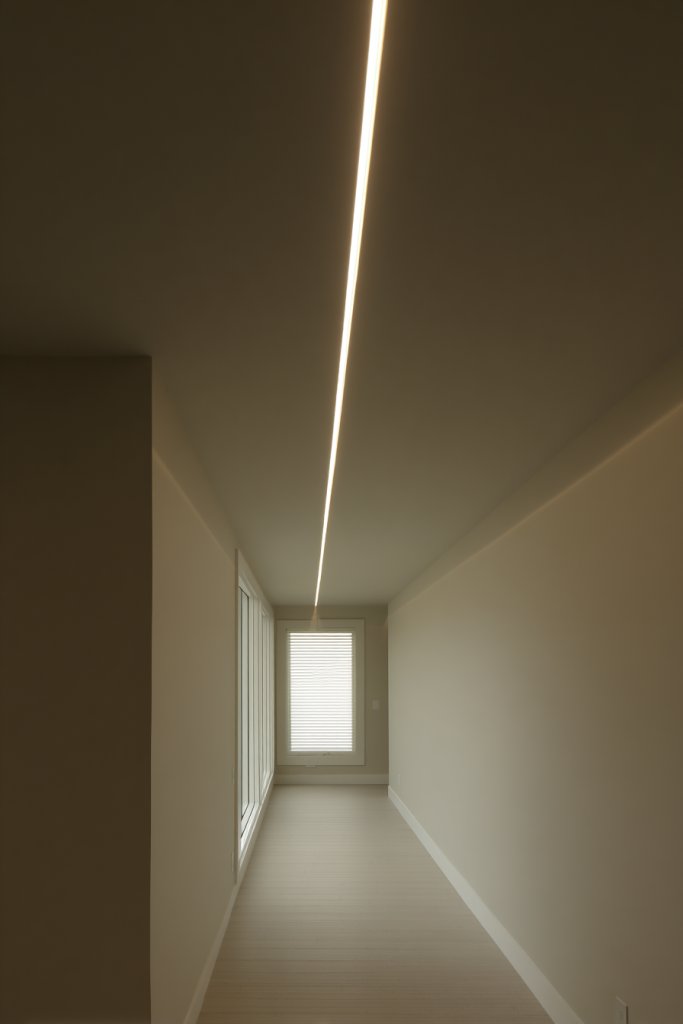
Long rooms can sometimes feel like they lack a sense of purpose or visual focus. Overhead lighting often emphasizes the ceiling rather than the room’s shape. Linear lighting fixtures draw attention to the length and create a cohesive look that enhances the room’s natural proportions.
Visualize elongated pendant lights or track lighting running parallel to the room’s length, casting even, diffused light across the space. The continuous line accentuates the room’s shape while providing ample illumination. When layered with wall sconces or floor lamps, the lighting creates a warm, inviting glow that highlights architectural features.
Select sleek, minimalist fixtures for a contemporary vibe, or vintage-inspired linear pendants for a cozy feel. Use adjustable track lighting to direct light exactly where needed. Integrate dimmable options to control ambiance. For a dramatic effect, choose fixtures with interesting shapes or finishes that complement your decor.
Determine the optimal placement along the ceiling to emphasize the room’s length. Install fixtures securely, ensuring electrical wiring is handled professionally. Use dimmers for flexibility in mood setting. Balance the lighting with natural light sources for a layered effect. Be mindful of height—install fixtures slightly below eye level for a cozy, intimate atmosphere. Regular maintenance ensures the fixtures stay in top shape.
Use decorative elements like frosted or textured glass to add interest. Incorporate color-changing LED options for versatility. Combine with accent lighting on artwork or architectural details. Personalize the space further with color-coordinated fixtures or unique shapes that match your style.
Linear lighting emphasizes the room’s proportions and creates a polished, intentional look. It elevates the overall ambiance and makes your long living space feel more cohesive. With the right fixtures, your room will glow with style and function—time to shed old lighting habits!
14. Place a Slim, Long Coffee Table to Maintain Flow
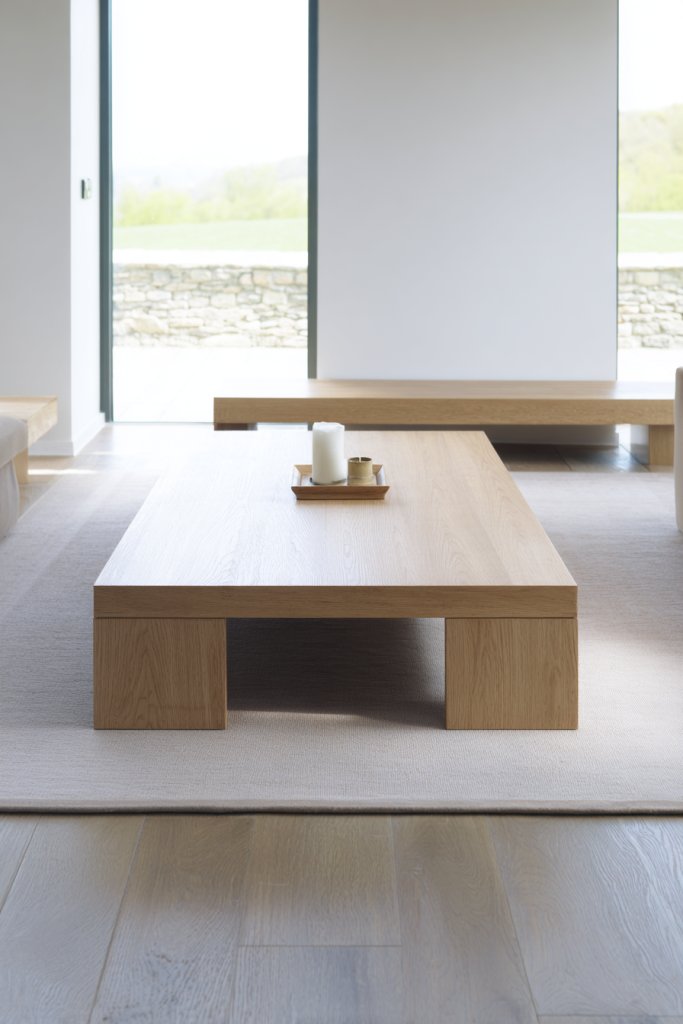
Long living rooms often suffer from bulky, oversized coffee tables that disrupt the flow and make the space feel cluttered. You need a table that fits the proportions without blocking pathways or crowding the seating area. A slim, elongated coffee table offers a sleek solution that keeps the room feeling open.
Picture a narrow, rectangular table running lengthwise across your seating area, with a soft runner or tray on top for style and function. The slim profile allows for easy movement around it, while the extended shape visually complements the room’s shape. Accessories like small vases or candles can add personality without overwhelming the space.
Choose materials like glass, wood, or metal for a modern or industrial look. For a softer touch, opt for rounded edges or textured surfaces. Use layered textiles or decorative trays to add visual interest. The length can be adjusted based on your seating arrangement, ensuring it doesn’t dominate the room.
Measure your seating area carefully to select a table that’s proportionate. Place it centrally, ensuring enough clearance for walking and seating. Keep accessories minimal and functional—think coasters, books, or small bowls. Consider lightweight materials for easy repositioning. For a cohesive look, match the table’s finish with other furniture accents.
Add a pop of color or texture with a fabric or leather cover. Incorporate decorative objects that reflect your personality. Use a combination of open and closed storage underneath for versatile use. Personal touches make the table a reflection of your style.
A slim, long coffee table maintains the room’s flow and enhances its proportions. It’s a subtle yet impactful way to add style and convenience. Once you choose the right piece, your space will feel more balanced and inviting. Ready to elevate your living area?
15. Use Monochromatic Color Schemes for a Cohesive, Open Feel

Color overload can make a long living room feel chaotic or fragmented. You want a unified look that feels calm and spacious. Monochromatic color schemes tie everything together, making your space appear larger and more harmonious.
Picture a room painted in soft shades of beige, with furniture, curtains, and accessories all in matching tones. Different textures—knits, velvets, woods—add depth without breaking the color palette. The consistent color creates a seamless visual flow, making the long space feel more connected and less busy.
Choose shades within the same color family—light neutrals, pastels, or deep hues—for a sophisticated look. Add subtle contrast with slightly darker or lighter accents. For a modern look, stick to matte finishes; for cozy vibes, incorporate some glossy or textured surfaces. Balance with varied materials to keep the scheme interesting.
Start by establishing your main color palette—walls, furniture, textiles. Keep accessories minimal and within the same color range. Use layered textures to prevent monotony. Incorporate lighting that enhances the palette, like warm LED or soft ambient lights. Use rugs, cushions, and throws to add variation within the scheme.
Incorporate personal touches like artwork, decorative pillows, or throws that stay within the color scheme. Use metallic or wood accents to add contrast without breaking the harmony. Keep clutter to a minimum to preserve the clean, cohesive look. Change accessories seasonally for freshness.
A monochromatic palette simplifies decorating and creates a tranquil, spacious atmosphere. It’s an easy way to achieve a sophisticated, curated look. Once you master this, your long living room will feel more expansive and stylish. Ready to embrace the power of one color?
16. Incorporate Modular Seating for Flexible Arrangements

Long living rooms can be tricky to arrange for different occasions. Fixed furniture limits flexibility, making it hard to adapt for parties, family nights, or quiet weekends. Modular seating offers a versatile solution that adapts to your changing needs.
Imagine a set of sectional pieces or individual chairs that can be moved and reconfigured easily. During gatherings, you create a U-shape or circle; for quiet nights, separate into smaller clusters. The neutral tones and sleek design blend seamlessly, giving your space a modern, adaptable vibe. The flexibility encourages spontaneous arrangements and makes your room multifunctional.
Choose pieces with hidden wheels or lightweight frames for easy movement. Opt for neutral colors that match various decor styles, from minimalist to boho. Incorporate a few accent pieces like ottomans or poufs for additional seating or table space. Use textured fabrics for visual interest and comfort.
Assess your space and identify how many configurations you need. Select modular pieces that can interlock or stand alone. Arrange the main units along the length of the room, leaving room for easy reconfiguration. Use rugs to define different setups. Store extra pieces conveniently nearby for quick changes. Ensure the design remains cohesive regardless of the layout.
Add throws, cushions, or covers in your favorite colors or textures. Incorporate personal items like vintage cushions or patterned fabrics for a unique touch. Use lighting to highlight different arrangements or create cozy zones. Keep the setup simple for quick transformation.
Modular seating empowers you to customize your space effortlessly. It’s perfect for entertaining or relaxing, making your long room highly functional. Once you get comfortable with reconfiguring, your space will always feel fresh and inviting. Ready to embrace this flexible approach?
17. Add Vertical Mirrors to Enhance Depth and Light
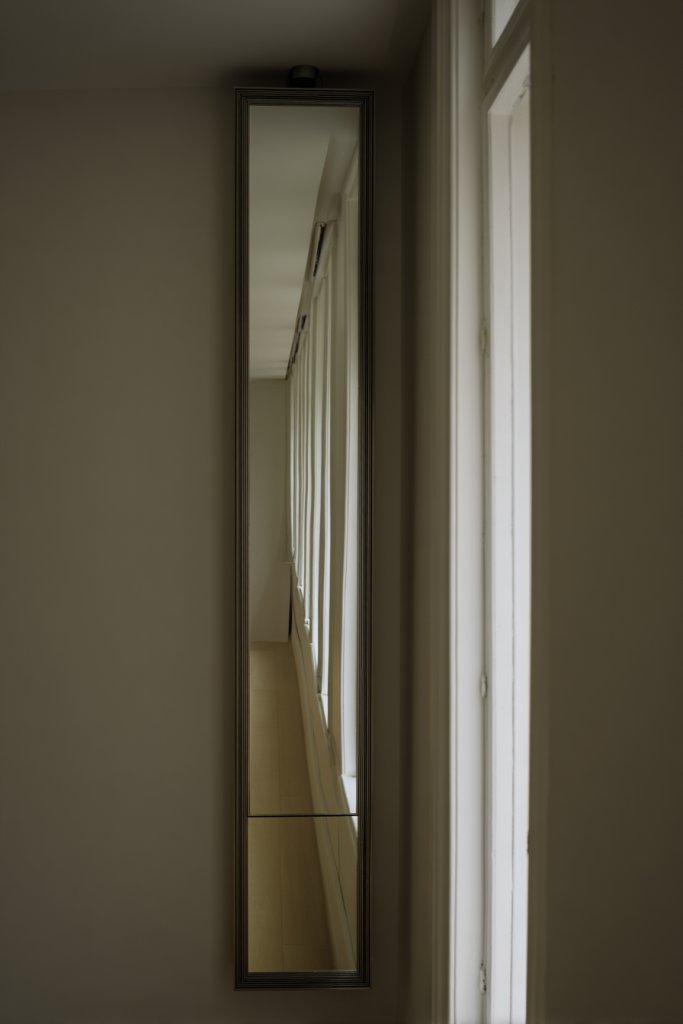
Long rooms often lack depth and can feel flat or dull. Without visual cues, they might seem even longer and less inviting. Vertical mirrors are a simple trick to create the illusion of more space and amplify natural light.
Picture tall, narrow mirrors mounted along the length of your wall, reflecting the room’s length and bouncing light from windows or artificial sources. The mirrors stretch your space visually, making it feel bigger and brighter. Their sleek frames add a modern, elegant touch that blends with various decor styles. The reflections create a sense of depth, inviting the eye to wander.
Choose full-length mirrors for maximum impact or multiple smaller ones arranged vertically for a layered look. Frames can be minimalist, ornate, or frameless, depending on your style. Use textured or metallic finishes to add contrast or complement existing hardware. Incorporate decorative elements like sconces or LED accents for added flair.
Position mirrors opposite windows or light sources for maximum reflection. Ensure they are securely mounted at eye level or higher for dramatic effect. Clean regularly to maintain clarity. Experiment with different arrangements before fixing. Consider incorporating a decorative frame or border for extra style. Use lighting to highlight the mirrors’ reflective qualities.
Decorate the mirrored area with artful frames or surround with subtle lighting to create a focal point. Use reflective surfaces in furniture or decor to double the effect. Personalize with photos or artwork, ensuring they don’t clutter the reflective space. Keep the surrounding decor simple to let the mirrors shine.
Mirrors are an affordable, effective way to visually expand your space and add light. They boost confidence in your design choices and create a more inviting, spacious ambiance. Once you incorporate mirrors thoughtfully, your long living room will feel instantly more open and vibrant. Time to reflect your style!
18. Design a Long, Narrow Entryway with a Console and Seating
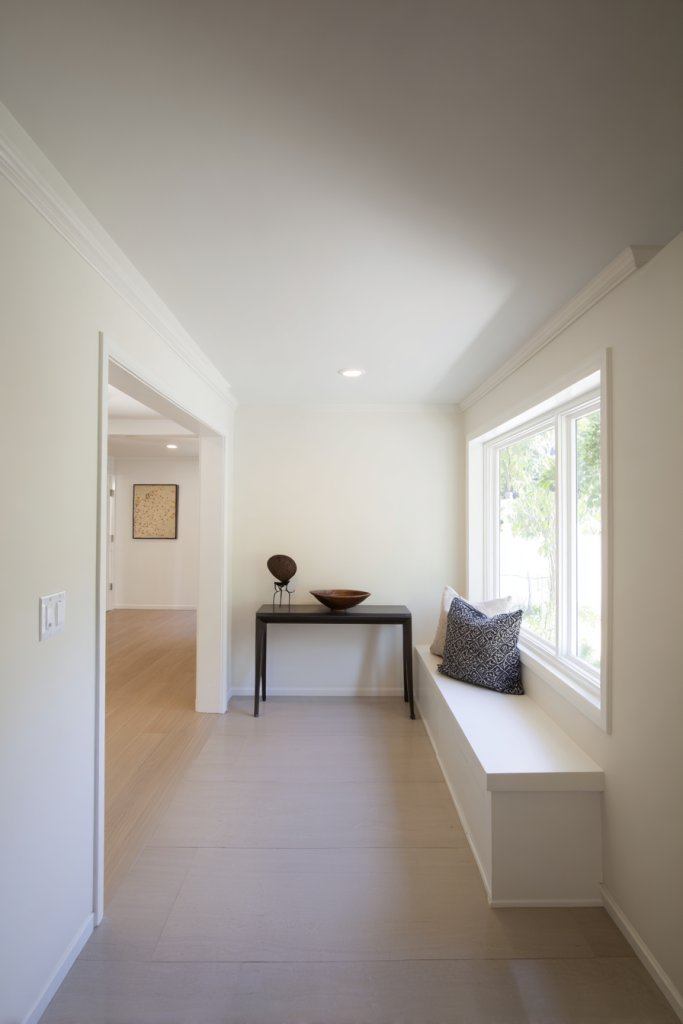
Long, open living rooms often lack a clear entry point, making the space feel disconnected or unfinished. You want a welcoming, defined transition that sets the tone for the rest of the room. A narrow console with seating creates an inviting entry that’s both functional and stylish.
Visualize a sleek console table lining the narrow entry, topped with a simple tray or decorative box for keys and essentials. A compact bench or stool provides a quick spot to sit while putting on shoes. The design maintains a clear pathway into the main living area, while the furniture adds visual interest and functionality. Soft lighting and textured wall finishes complete the look.
Choose minimalist consoles in wood, metal, or lacquer. For a cozy feel, add cushions or textured upholstery to the seating. Use baskets or storage drawers underneath for extra organization. Style with a mirror or artwork above the console—just ensure it doesn’t overcrowd the space.
Measure your entry area carefully before selecting furniture. Position the console flush against the wall, leaving enough clearance for walking. Place a small seat or stool nearby, ensuring it doesn’t block the pathway. Add lighting—wall sconces or a small table lamp—to brighten the space. Use rugs to define the area and add warmth.
Personalize with decorative items like textured bowls, small sculptures, or seasonal accents. Incorporate a mirror or artwork that reflects your style. Use color-coordinated accessories for a cohesive look. Keep clutter out of sight to maintain a clean, welcoming vibe.
A thoughtfully designed entryway makes your long living room feel more connected and inviting. It adds a touch of elegance and order, setting the mood for the entire space. With a few simple pieces, you’ll transform an empty corridor into a charming welcome area. Time to make that entry count!
19. Integrate Subtle Architectural Elements to Break Up the Space
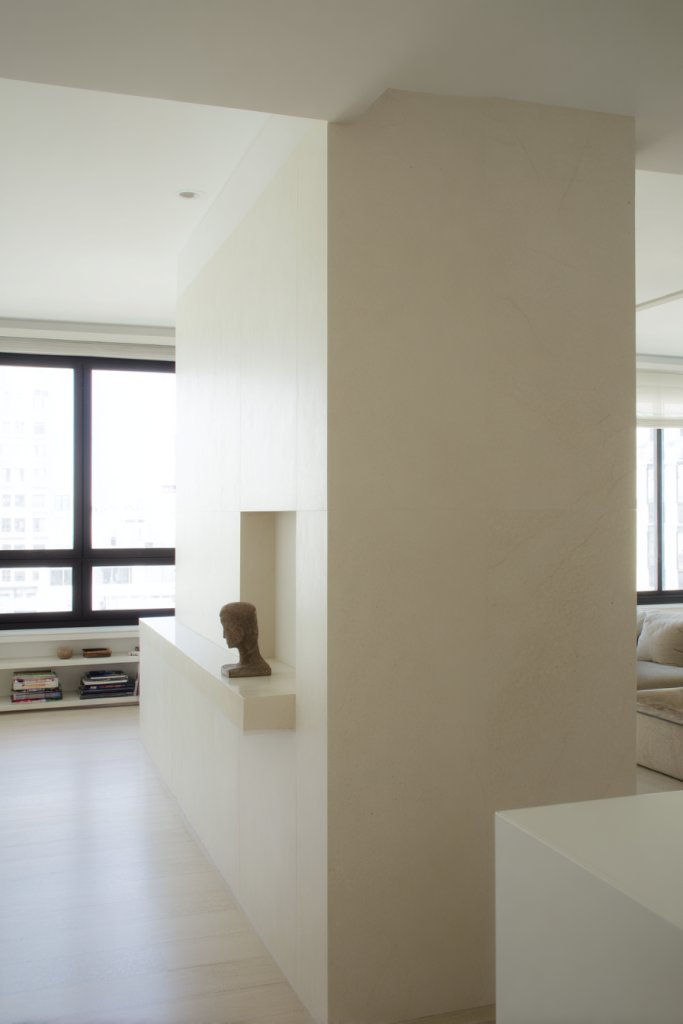
Long, open spaces can sometimes feel monotonous or overwhelming. You want to add architectural interest that breaks the linearity without closing off the room. Subtle features like partial walls, columns, or ceiling beams can create visual separation while maintaining openness.
Imagine a partial wall with a built-in bookshelf or a half-height divider that separates the seating from the dining area. Exposed beams draw the eye upward, emphasizing the room’s length and height. Columns or archways subtly define different zones, adding texture and depth. The architectural details create a layered, sophisticated look that invites exploration.
Choose materials that match your decor—wood, stone, or painted finishes. Keep structural elements minimal to avoid clutter. For a modern look, opt for sleek, clean-lined features; for a rustic vibe, incorporate natural textures. Use lighting to highlight these features, such as spotlights or uplights.
Work with a contractor or architect to incorporate these elements seamlessly. Decide which features will best serve your style and space—partial walls, beams, or columns. Use durable, lightweight materials for ease of installation. Ensure structural safety and code compliance. Integrate lighting to accentuate the architectural details effectively.
Add decorative finishes like paint, wallpaper, or textured plaster to enhance the features. Use complementary furniture to align with the architectural style. Personalize with artwork or decorative objects on shelves or ledges. Keep the design subtle enough to avoid overwhelming the space.
Subtle architectural details elevate your long living room from basic to breathtaking. They add depth and character, making the space feel thoughtfully designed and inviting. Once integrated, these elements will enhance your home’s overall aesthetic and functionality. Ready to add architectural interest?
20. Use Continuous Flooring to Unify the Entire Space
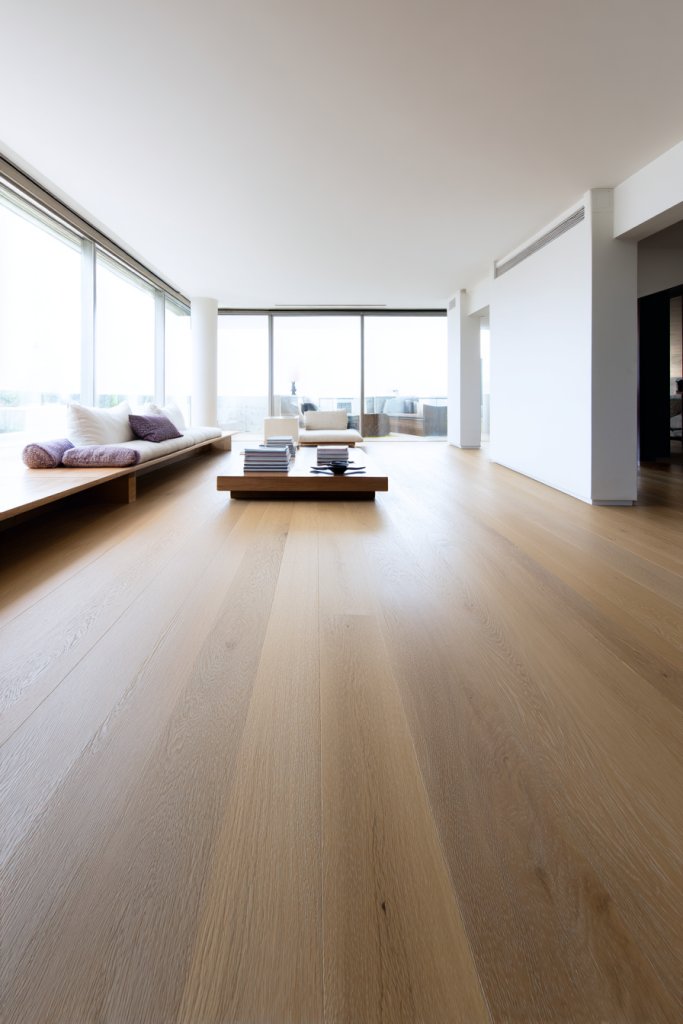
Fragmented flooring can make a long room feel disjointed or segmented, breaking the visual flow. You want a unified look that stretches from one end to the other, making the space appear larger and more cohesive. Continuous flooring is the easiest way to achieve this effect.
Imagine hardwood planks or large-format tiles running uninterrupted across the entire length of your living area. The seamless surface guides the eye along the room’s axis, emphasizing its length. The consistent material and color create a clean, harmonious background that allows your furniture and decor to stand out.
Choose flooring materials that suit your style—warm wood for a cozy feel, sleek tiles for a modern aesthetic, or polished concrete for industrial vibes. Use the same flooring throughout adjacent rooms for a truly open-plan look. Incorporate area rugs over the continuous surface for zones or accents.
Work with flooring professionals to ensure a smooth, level installation. Remove existing flooring and prepare the subfloor properly for a durable finish. Match the grain or pattern to your interior theme for a cohesive appearance. Seal or treat the surface as needed for longevity. Avoid transitions or thresholds that break the continuity.
Add rugs or runners at key points to define areas without interrupting the flow. Use furniture placement to highlight the continuous surface—avoid breaking it up with small rugs or multiple flooring types. Incorporate color-coordinated furniture to complement the flooring.
A seamless floor visually elongates your space, making it more inviting and stylish. It simplifies decorating and creates a cohesive look that enhances your entire home. Once you choose continuous flooring, your long room will feel more expansive and polished. Time to unify your space!
21. Incorporate Soft Textures and Warm Tones for Comfort

Long living rooms can sometimes feel cold or uninviting, especially if decor is too sleek or stark. You want to add warmth and softness to create a cozy, welcoming environment. Textiles and warm hues make your space feel more intimate and comfortable.
Imagine plush throws draped over sofas, textured cushions in warm shades, and soft area rugs underfoot. Warm tones like caramel, rust, or beige dominate the palette, creating a soothing backdrop. Layering different textures—knits, velvets, and woven fabrics—adds depth and tactile interest. The overall effect is inviting and relaxing.
Choose textiles that match your style—rustic, modern, or eclectic. Incorporate a variety of textures to prevent monotony. Use warm-colored upholstery, curtains, and accessories to create harmony. Seasonal textiles like faux fur or velvet can be swapped to update the vibe.
Start by selecting soft, tactile fabrics for cushions and throws. Layer rugs with different textures and colors for visual richness. Use warm, ambient lighting to enhance the cozy atmosphere. Incorporate furniture in warm wood or upholstered pieces in inviting fabrics. Keep the decor simple to focus on the textures and tones.
Add personal touches like embroidered cushions or handmade textiles. Use candles or warm lighting to amplify the cozy feel. Incorporate decorative blankets or textiles that reflect your personality and style. Balance textures and tones to maintain a harmonious, inviting space.
Soft textures and warm tones turn a long living room into a comforting retreat. They encourage relaxation and make your space more inviting for family and friends. Once you embrace tactile richness, your room will feel like a warm hug every time you enter. Time to add those cozy layers!
Conclusion
From open-concept arrangements to cozy sectional placements, these long living room layout ideas showcase the versatility and endless potential of open spaces. Feel empowered to experiment with different configurations and make your living room a true reflection of your style and needs. Embrace these ideas and take the first step toward creating a stunning, functional, and welcoming space that you’ll love coming home to every day.